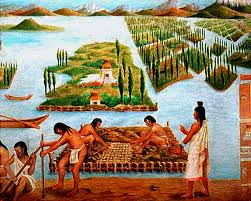Natural Filtration 301 Chapter 1
Large-scale Bog Agriculture of Mesoamerica
 As you would expect, the more water that comes in contact with the plants, the more nutrients can be taken up and the faster plants will grow, so long ago many different peoples came up with ways to maximize contact, not to use up nutrients, but to turn them into edible crops. In ancient Mexico the Aztecs of Tenochtitlan developed chinampas, artificial islands created by staking out a perimeter wall of branches in the shallow lake and filling it with vegetation and muck from the lake bottom. Planted with maize, beans, squash and chiles, these passive bogs provided 3-4 harvests a year, effectively doubling food output and allowing them to support a city of perhaps a quarter of a million people, far larger than the cities of Europe at the time. Misnamed “floating islands”, chinampas are so productive that the technique survives to this day in the gardens of Xochimilco in modern Mexico City, 600 years later.
As you would expect, the more water that comes in contact with the plants, the more nutrients can be taken up and the faster plants will grow, so long ago many different peoples came up with ways to maximize contact, not to use up nutrients, but to turn them into edible crops. In ancient Mexico the Aztecs of Tenochtitlan developed chinampas, artificial islands created by staking out a perimeter wall of branches in the shallow lake and filling it with vegetation and muck from the lake bottom. Planted with maize, beans, squash and chiles, these passive bogs provided 3-4 harvests a year, effectively doubling food output and allowing them to support a city of perhaps a quarter of a million people, far larger than the cities of Europe at the time. Misnamed “floating islands”, chinampas are so productive that the technique survives to this day in the gardens of Xochimilco in modern Mexico City, 600 years later.
Long dismissed as fantasy, we now know that huge areas of the Amazon River basin, the Beni savannahs of Moxo, now part of Bolivia, were carved into canals and raised beds, seasonal constructed wetlands that trapped the yearly floodwaters and nutrient-rich sediments, partitioned by elevated causeways made of broken pottery, basket pieces and other “trash”. For three thousand years the inhabitants processed their animal and human sewage and refuse into a vast man-made and managed garden of fruits and nuts, grains and greens. More than 50,000 square miles of irrigated raised fields and fish weirs supported numerous villages, towns and large cities, millions of people over a vast area, an elegant solution to both managing the wastes and supplying the food for an entire society. The same principles that cleaned the water and fed these peoples of Mesoamerica and many other societies will consume the nutrients in our ponds, generate lush plant growth, starve out algae and return excellent water quality. (It can even provide food for the table – why just plant inedible ornamentals? – but Aquaponics is a separate topic.)

Long dismissed as fantasy, we now know that huge areas of the Amazon River basin, the Beni savannahs of Moxo, now part of Bolivia, were carved into canals and raised beds, seasonal constructed wetlands that trapped the yearly floodwaters and nutrient-rich sediments, partitioned by elevated causeways made of broken pottery, basket pieces and other “trash”. For three thousand years the inhabitants processed their animal and human sewage and refuse into a vast man-made and managed garden of fruits and nuts, grains and greens. More than 50,000 square miles of irrigated raised fields and fish weirs supported numerous villages, towns and large cities, millions of people over a vast area, an elegant solution to both managing the wastes and supplying the food for an entire society. The same principles that cleaned the water and fed these peoples of Mesoamerica and many other societies will consume the nutrients in our ponds, generate lush plant growth, starve out algae and return excellent water quality. (It can even provide food for the table – why just plant inedible ornamentals? – but Aquaponics is a separate topic.)




